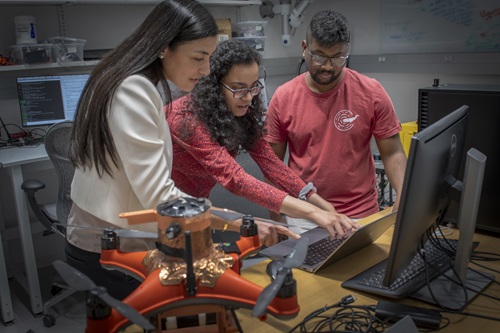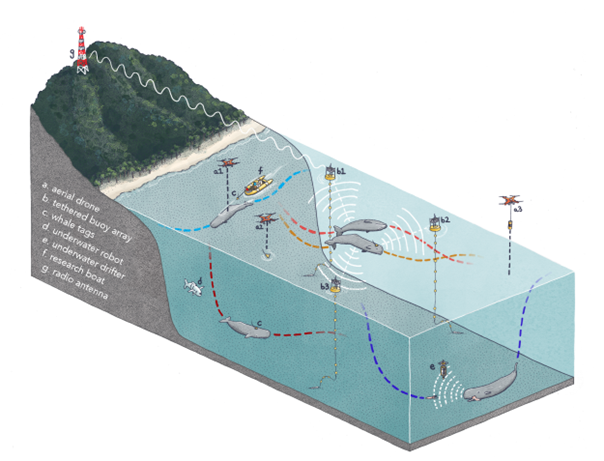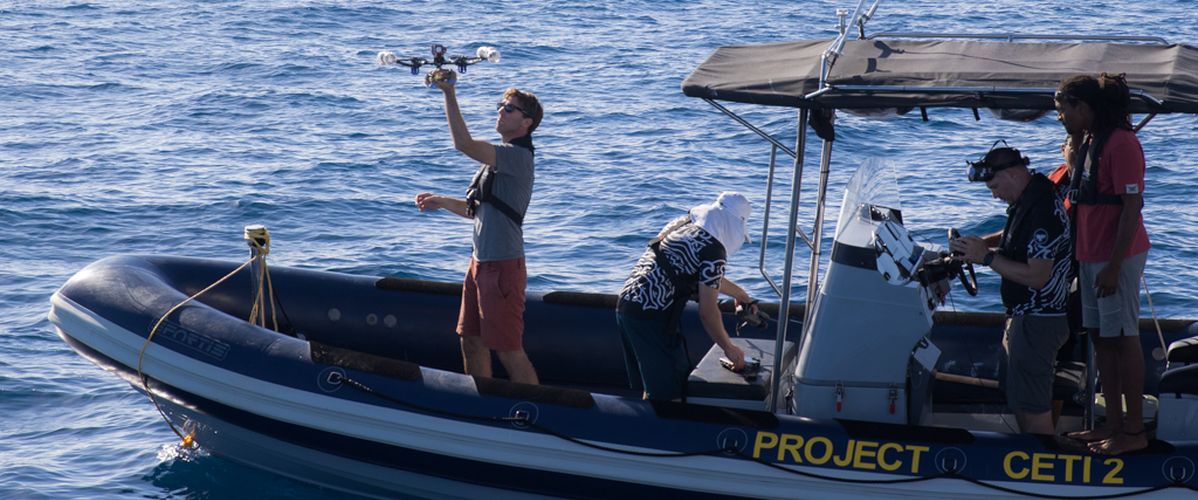● The drones are equipped with a very high frequency (VHF) signal detection system to enhance the tracking of the whales, which have been tagged with radio beacons.
● This data in combination with information from underwater microphones has enabled the team to predict where sperm whales will surface so that they can observe their social behaviour.
The ability to model animal behaviour, which is often a difficult task, is essential if we are to understand the impact of human activity on wildlife. This is notably the case in the field of marine biology, where a major project is underway to develop our knowledge of some of the world’s largest mammals. In the Cetacean Translation Initiative (CETI), researchers plan to extensively study (but discreetly and without disturbing them) the manner in which sperm whales communicate with a view to obtaining precious insights on their language and social behaviour. The team has tracked these animals with tags that emit radio signals and collect water-pressure and temperature readings, now they aim to collect comprehensive data on their activity when they surface, a time when they socialise and change their language. To observe the sperm whales behaviour during these moments, they will need to predict where and when these rendezvous are about to happen.

Stephanie Gil, Sushmita Bhattacharya and Ninad Jadhav of REACT Lab (Robotics, Embedded Autonomy & Communication Theory Lab) at Harvard (crédit : Stu Rosner)
Our objective is to facilitate understanding of whale language and physical interactions, and also reduce time- and effort-intensive boat trips.
“A team of biologists provided us with a model that allows us to understand the whales’ behaviour. The plan is to be able to listen to them by sending a drone that to the spot where they surface at the right time. If we miss this rendezvous, we have to wait an hour for another opportunity,” explains Sushmita Bhattacharya, a Harvard researcher on the CETI team. “Our objective is to find a solution to automate audio-visual data collection that facilitates our understanding of whale language and physical interactions, and also reduces time- and effort-intensive boat trips.”

Different data sources
In their article in ScienceRobotics, the researchers have published details of a reinforcement learning-based framework to predict the timing and location of rendezvous points where sperm whales surface, which will allow for the automatic dispatch of drones to observe and collect measurements on these meetings. Several sources of information were used to train the model, including audio from hydrophones (underwater microphones towed by a research boat) and very high frequency signals (VHF) from whale tags. Drones were also deployed to capture tag signals and enhance the precision of recorded data. To better understand the surface language of the sperm whales, researchers also trained the model with underwater vocalizations the animals use to communicate while hunting.
Overcoming particular technical challenges
In their drive to achieve the apparently simple objective of the research project, the researchers had to address a number of technical challenges. “The first of these relates to the collection of data by the drones and research boats, because we have to be certain that a drone can be sent to collect data at the exact spot where the sperm whales return to the surface to socialise,” explains Ninad Jadhav a doctoral student under Stephanie Gil at Harvard University’s REACT (Robotics, Embedded Autonomy & Communication Theory) lab. “We have also had to build robots that are sufficiently robust to function on tropical islands;” he adds. The experiments for the research project are being conducted off the coast of Dominica (a Caribbean island located between Martinique and Guadeloupe). “The underwater acoustic signals are very noisy, and the audio signals are not sufficient to enable us to precisely locate the animals,” points out Sushmita Bhattacharya. To better locate the sperm whales before the dispatching a drone, the researchers have opted to make use of an algorithm that analyses phase information (the relative position of waveform peaks) from the tag signals rather than signal intensity. “The phase of the emitted signals allows us to precisely measure differences if sperm whales are moving.”
Encouraging results
With regard to the experimental objective of predicting surface rendezvous points, when using two drones within a radius of 1,000 metres and with postprocessing of data collected in the field, in this instance only acoustic data, the model accurately predicted where whales would emerge 69% of the time. With the addition of tag signals from an engineered whale (a speedboat equipped with a VHF beacon that mimicked five distinct whale trajectories with different movements) the aggregate success rate was over 80%.

Top picture: Rob Wood (Harvard / CETI), deploying a drone in Dominica
 Sushmita Bhattacharya
Sushmita Bhattacharya
 Ninad Jadhav
Ninad Jadhav











